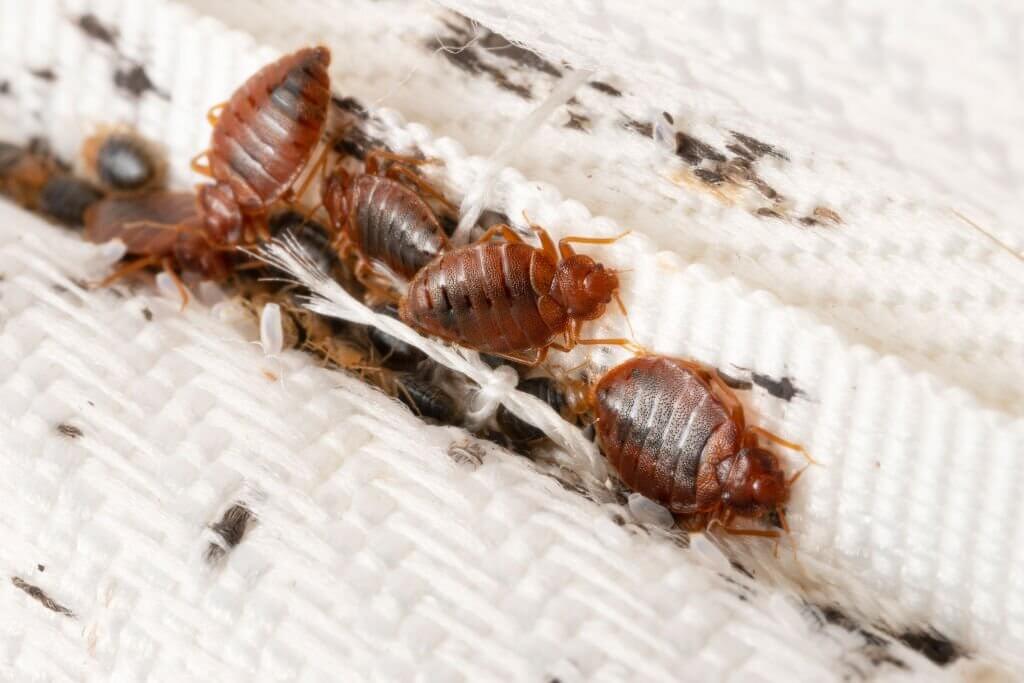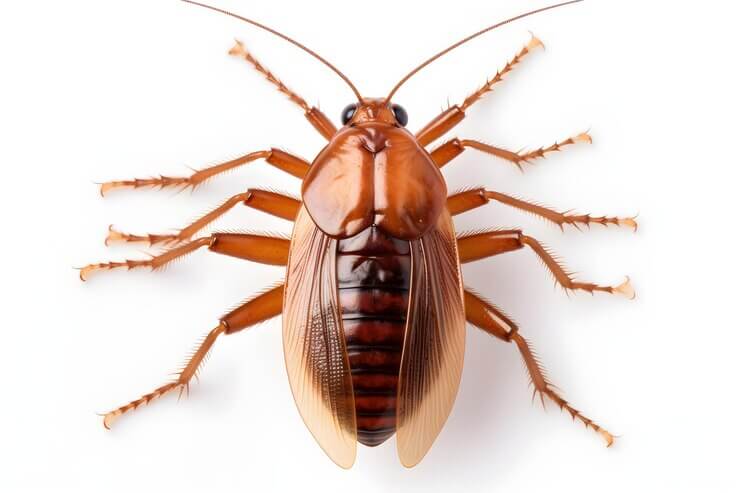Ready to learn how to tell if bed bugs are gone for good? Bed bugs can be a relentless nuisance, difficult to eradicate exterminators often have difficulty tracking down and eradicating all of these pests.
Interestingly enough, they can survive up to 18 months without feeding. But don’t throw your hands up in despair yet – while this may seem like an uphill battle, there are ways you can check for signs that the bed bugs have been eliminated from your home.
In this blog post, we’ll share with you tips on how you confirm if the infestation is truly gone both quickly and safely! Let’s get started so that you can finally reach sweet relief!
Signs of a Bed Bug Infestation
Common signs of bed bug infestation include itchy bites, dark spots or stains on the bed sheets and mattresses, musty odor, eggshells and skin casings, disturbed sleep patterns, and presence of active bed bugs.

Itchy bites
Bed bug bites typically result in an itchy rash on the skin, with an area near the site of the bite often becoming raised or bumpy. Bed bug bites usually cause small, reddish welts and can be very itchy depending on individual sensitivity.
Some people may experience more intense symptoms such as severe itching, blisters, hives or even a fever associated with multiple bed bug bites. Allergic reactions to bedbug bites can also occur in some individuals and may include intense itchiness, painful swelling, fever, flu-like symptoms and blisters.
It is also common for most people affected by a bedbug infestation to notice distinct zigzag patterns where several bite marks are arranged in straight lines along their body from the same feeding episode shortly after they wake up.
Dark spots or stains on bed sheets and mattresses
are tell-tale signs of a bed bug infestation. Rusty or reddish in color, these spots may resemble small pinpoint dark marks or fecal spots which could be from the activity of bed bugs.
Blood stains on sheets and mattresses can also indicate that the bugs have recently feasted and vacated them. In certain cases, eggshells and skin casings left behind after the shedding of their exoskeleton are further indications that there is an active presence of bed bugs nearby.
Identifying these common signs can help homeowners, tenants, landlords, travelers and other individuals living in urban areas to take action quickly if they suspect an infestation before it gets worse.
Musty odor
The musty odor commonly associated with bed bugs is unmistakable and can alert homeowners, renters, landlords, pest control professionals, parents, travelers, people living in urban areas and those interested in hygiene and cleanliness of a potential infestation.
Bed bug feces has a rusty smell that may be detected when an area of the home or business is heavily populated by them. Additionally, bed bugs have scent glands on the lower side of their bodies which produce a musty-sweetish odor that smells similar to coriander when they feel threatened.
The smell released by these glands provides definitive evidence for the presence of bed bugs if it is present which increases throughout an infestation until dealing with it becomes inevitable.
Eggshells and skin casings
are a telltale sign of an infestation of bed bugs. These remains from the molting process as a bug matures, they can range in size and shape but can generally be identified due to their small size and uniquely ribbed surface.
They often form clusters between mattresses, crevices, cracks or other hidden areas where bed bugs may lay eggs. These eggshells and skin casings usually appear white in color but if disturbed or damaged then will have a rusty or reddish stain which indicate the presence of active bugs in that particular area with potential for infestation risk.
Homeowners, landlords, pest control professionals as well as healthcare facilities should keep an eye out for these signs when inspecting rooms for beds bug activity and take appropriate action immediately to prevent further spread of any potential infestations.
Disturbed sleep
Seeing warning signs of a potential bed bug infestation, such as itchy bites, dark spots or stains on bed sheets and mattresses, musty odors as well as the presence of eggshells and skin casings can be extremely distressing.
Bed bugs are known to disrupt sleep quality with their constant biting during the night causing many people to experience insomnia, restlessness, nightmares and other forms of disturbed sleep.
Statistics show that exposure to these parasites can lead to psychological distress resulting in an increased stress response which may include symptoms like difficulty sleeping through the night due to fear or anxiety associated with bed bugs as well as severe cases such as sleep deprivation disorder or even an anxiety disorder.
Presence of active bed bugs

is one of the primary and decisive factors in determining if a home or other property has an infestation. Bed bugs are small, flat parasites that hide during the day in mattresses, bed frames, carpets, furniture and even electrical outlets or appliances.
Itchy bites and dark spots on sheets and bedding may indicate their presence. In some cases with severe infestations, active bed bugs may be seen scurrying around at night along walls or floors.
Additionally, a musty smell coming from mattresses is another dead giveaway that you have an undesirable guest living inside your walls! Unfortunately for those affected by a bed bug infestation, it can cause not only massive stress but also tumors resulting from scratching too hard to get rid of the itching caused by these insects’ saliva getting into our skin when they bite us while we sleep!
How to Confirm if Bed Bugs Are Gone
To confirm if bed bugs are gone, it is best to hire a professional pest extermination service, install bed bug monitors or interceptors around the house, monitor any vacant rooms closely and continue monitoring even after treatment.
Hire a professional pest extermination service
If you are dealing with a bed bug infestation, the best way to confirm if they are gone is by seeking help from an experienced professional. Hiring a professionally certified Pest Management Professional (PMP) who specializes in treating bed bugs will not only save time and money but also ensure the safety of your family and pets.
Professionals have experience in properly identifying signs of bed bugs such as itchy bites, dark spots or stains on mattresses and sheets, musty odor, eggshells and skin casings as well as their ability to disturb sleep.
PMPs use advanced equipment such as specialized monitors or interceptors to detect these pests early on so that proper treatment can be administered quickly before a full-blown infestation takes place.
Additionally, regular monitoring needs to occur for ongoing eradication efforts since even one active pest can signify the presence of an entire colony within walls or crevices which may cause re-infestation down the road if left undiscovered for too long.
Continued monitoring
Continued monitoring is essential in confirming if bed bugs are gone after a successful treatment. Traps such as sticky traps or glue boards can be used to effectively monitor for evidence of bed bugs, and should ideally contain no live insects if the treatment has been effective.
A professional pest control service must also inspect the premises at least every 7 days to check for any remaining eggs that may have been overlooked during initial inspections. To confirm a bed bug infestation, it’s essential to detect either active pests themselves or their signs – such as shed skins, eggshells and fecal spots on furniture and mattresses.
Bed bug management guidelines recommend inspecting for bed bugs regularly in order to determine whether they have been successfully eliminated from an area or not. This includes making sure furnishing items like boxes and mattresses are free of insects when moving into new spaces – this applies especially for second-hand furniture buyers and Airbnb hosts who need continued monitoring around their property.
Install bed bug monitors or interceptors
Bed bug monitors and interceptors are recommended to confirm if bed bugs have indeed been eliminated from a home. Monitors use attractants to lure active or inactive bed bugs out of hiding places so they can be detected, while interceptors place physical barriers between hosts and the areas in which bedbugs frequent.
Studies have shown that using traps for bedbug detection is more effective than visual inspections alone, as they make it possible to detect low numbers of insects with greater accuracy.
It is thought that at least a week’s monitoring should occur before any attempt is made to assess the success of control treatments.
Monitoring vacant rooms
is a key part of determining whether or not bed bugs have been eliminated. Setting up traps in vacant rooms, using the help of professional pest extermination services, can provide essential information on whether or not any signs of infestation remain after treatment.
Furthermore, it’s important to regularly inspect the traps for evidence of bed bugs as they are quite difficult to detect due to their small size and transient behavior. To ensure that all bedbugs are truly gone, it is recommended to continue monitoring these empty rooms for at least one year following the initial treatment.
Through sustained surveillance and regular inspections, we can make sure any existing or new infestations have been detected before they become an even bigger problem than before!
Preventing a Re-infestation
To ensure that your home remains bed bug-free, learn how to identify and understand the lifespan of these pests so you can implement measures to prevent a re-infestation before it happens.
Lifespan of bed bugs
Bed bugs are resilient and notoriously hard to get rid of. Part of the reason is due to their lengthy development cycle, which starts from eggs and can reach up to an adult bed bug in twenty-one days.
The female bed bugs can lay 1-5 eggs per day and upwards of 541 eggs in their lifetime. These developments range from nymphs (juveniles) that molt five times over 14-21 days, through gradual feeding stages ending with adulthood for both males and females.
During each stage they will require a blood meal before emerging as adults or maturing into the next stage – without a suited environment i.e: food, warmth & moisture most won’t survive past 48 hours without these stimuli’s.(Factcheck).
In addition, bedbugs have remarkable survival characteristics; they can go on fasting for several months when faced with unfavorable conditions such as extreme temperatures or lack of food resources (factcheck).
9 important steps to prevent a re-infestation
To prevent a re-infestation of bed bugs, individuals should take certain actions:
- Hire a professional pest extermination service for removal and to provide advice on prevention measures.
- Continue monitoring for signs of an infestation and act to deter them if observed.
- Install bed bug monitors or interceptors in the living area to help detect any further infestations quickly.
- Monitor vacant rooms, closets, or other areas prone to bed bug infestations after regular treatments.
- Learn about the lifespan of bed bugs – they can live 6-12 months without feeding – which can help you know when they are gone from your residence completely.
- Take steps to reduce clutter around where people sleep – this keeps areas clear and tightens the easier sites of entry for bed bugs into your home.
- Vacuum regularly using extension hoses and special attachments that capture both live bugs and eggs, then ensure that the vacuum contents are immediately disposed in sealed bags outside of the home; perform regular cleaning habits for mattresses, box springs, carpets, etc., as well as behind headboards and furniture.
- Seal cracks and crevices around baseboards, windowsills, light switches/outlet plates where bed bugs have been known to hide throughout various stages of their life cycle in order to prevent spread within the home.
- Pay particular attention in multi-unit dwellings such as apartments where neighbors may unknowingly share issues across units based on poor insulation between walls/floors occupancy within neighboring units being shared by among different parties over time without proper inspection before transition into each new period of occupancy.


